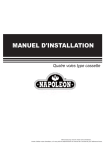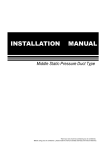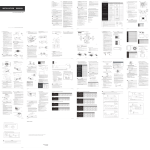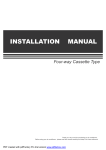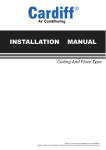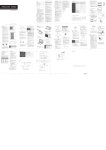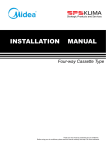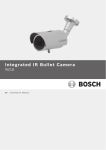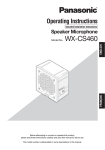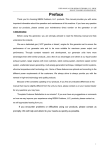Download INSTALLATION MANUAL
Transcript
INSTALLATION MANUAL Four-way Cassette Type Install according to this installation instructions strictly. If installation is defective, it will cause water leakage, electrical shock and fire. CONTENTS PAGE PRECAUTIONS...................................................................... 1 INSTALLATION INFORMATION............................................. 2 ATTACHED FITTINGS............................................................ 3 When installing the unit in a small room, take measures against to keep refrigerant concentration from exceeding allowable safety limits in the event of refrigerant leakage. Contact the place of purchase for more information. Excessive refrigerant in a closed ambient can lead to oxygen deficiency. INSPECTING AND HANDLING THE UNIT............................. 4 INDOOR UNIT INSTALLATION.............................................. 4 OUTDOOR UNIT INSTALLATION.......................................... 10 INSTALL THE CONNECTING PIPE....................................... 14 CONNECT THE DRAIN PIPE................................................ 17 CONNECTIVE DIAGRAM ..................................................... 18 INSTALLATION OF FLANGE AND DUCT.............................. 19 WIRING................................................................................... 20 Use the attached accessories parts and specified parts for installation. otherwise, it will cause the set to fall, water leakage, electrical shock and fire. Install at a strong and firm location which is able to withstand the set' s weight. If the strength is not enough or installation is not properly done, the set will drop to cause injury. The appliance must be installed 2.3m above floor. TEST OPERATION................................................................. 21 The appliance shall not be installed in the laundry. Before obtaining access to terminals, all supply circuits must be disconnected. The appliance must be positioned so that the plug is accessible. 1. PRECAUTIONS Keep this manual where the operator can easily find them. Read this manual attentively before starting up the units. For safety reason the operator must read the following cautions carefully. The safty precautions listed here are divided into two categories. WARNING If you do not follow these instrutions exactly, the unit may cause property damage, personal injury or loss of life. CAUTION If you do not follow these instrutions exactly, the unit may cause minor or moderate property damage, personal After completing the installation, make sure that the unit operates properly during the start-up operation. Please instruct the customer on how to operate the unit and keep it maintained.Also, inform customers that they should store this installation manual along with the owner's manual for future reference. WARNING Be sure only trained and qualified service personnel to install, repair or service the equipment. Improper installation, repair, and maintenance may result in electric shocks, short-circuit, leaks, fire or other damage to the equipment. The enclosure of the appliance shall be marked by word, or by symbols, with the direction of the fluid flow. For electrical work, follow the local national wiring standard, regulation and this installation instructions. An independent circuit and single outlet must be used. If electrical circuit capacity is not enough or defect in electrical work, it will cause electrical shock or fire. Use the specified cable and connect tightly and clamp the cable so that no external force will be acted on the terminal. If connection or fixing is not perfect, it will cause heat-up or fire at the connection. Wiring routing must be properly arranged so that control board cover is fixed properly. If control board cover is not fixed perfectly, it will cause heat-up at connection point of terminal, fire or electrical shock. If the supply cord is damaged, it must be replaced by the manufacture or its service agent or a similarly qualified person in order to avoid a hazard. An all-pole disconnection switch having a contact separation of at least 3mm in all poles should be connected in fixed wiring. When carrying out piping connection, take care not to let air substances go into refrigeration cycle. Otherwise, it will cause lower capacity, abnormal high pressure in the refrigeration cycle, explosion and injury. Do not modify the length of the power supply cord or use of extension cord, and do not share the single outlet with other electrical appliances. Otherwise, it will cause fire or electrical shock. Carry out the specified installation work after taking into account strong winds, typhoons or earthquakes. Improper installation work may result in the equipment falling and causing accidents. installation manual 1 If the refrigerant leaks during installation, ventilate the area immediately. Toxic gas may be produced if the refrigerant comes into the place contacting with fire. The temperature of refrigerant circuit will be high, please keep the interconnection cable away from the copper tube. After completing the installation work, check that the refrigerant does not leak. Toxic gas may be produced if the refrigerant leaks into the room and comes into contact with a source of fire, such as a fan heater, stove or cooker. CAUTION Ground the air conditioner. Do not connect the ground wire to gas or water pipes, lightning rod or a telephone ground wire.Inappropriate grounding may result in electric shocks. Be sure to install an earth leakage breaker. Failure to install an earth leakage breaker may result in electric shocks. Connect the outdoor unit wires , then connect the indoor unit wires. You are not allowed to connect the air conditioner with the power supply until the wiring and piping is done. While following the instructions in this installation manual, install drain piping in order to ensure proper drainage and insulate piping in order to prevent condensation. Improper drain piping may result in water leakage and property damage. Install the indoor and outdoor units, power supply wiring and connecting wires should be at least 1 meter away from televisions or radios in order to prevent image interference or noise. Depending on the radio waves, a distance of 1 meter may not be sufficient enough to eliminate the noise. The appliance is not intended for use by young children or infirm persons without supervision. Don't install the air conditioner in the following circumstance: There is petrolatum existing. There is salty air surrounding (near the coast). There is caustic gas (the sulfide, for example) existing in the air (near a hot spring). The Volt vibrates violently (in the factories). In buses or cabinets. In kitchen where it is full of oil gas. There is strong electromagnetic wave existing. There are inflammable materials or gas. There is acid or alkaline liquid evaporating. Other special conditions. installation manual 2 2. INSTALLATION INFORMATION To install properly, please read this "installation manual" at first. The air conditioner must be installed by qualified persons. When installing the indoor unit or its tubing, please follow this manual as strictly as possible. If the air conditioner is installed on a metal part of the building, it must be electrically insulated according to the relevant standards to electrical appliances. When all the installation work is finished, please turn on the power only after a thorough check. Regret for no further announcement if there is any change of this manual caused by product improvement. INSTALLATION ORDER Select the location; Install the indoor unit; Install the outdoor unit; Install the connecting pipe ; Connect the drain pipe; Wiring; Test operation. 3. ATTACHED FITTINGS Please check whether the following fittings are of full scope. If there are some spare fittings , please restore them carefully. NAME INSTALLATION FITTINGS 1. Installation paper board SHAPE QUANTITY 1 2. Soundproof / insulation sheath 2 3. Connecting pipe group 1 4. Out-let pipe sheath 1 5. Out-let pipe clasp 1 6. Drain joint 1 7. Seal ring 1 8. Remote controller(on some models) 1 9. Remote controller holder (on some models) 1 10 Mounting screw(ST2.9×10-C-H) 2 11. Alkaline dry batteries (AM4) 2 Tubing & Fittings Drainpipe Fittings Remote controller & Its Frame Installation accessory (The product you have might not be provided the following accessory) 12. Owner's manual 1 13. Installation manual 1 14. Expansible hook 4 15. Installation hook 4 16 .Orifice (on some models) 1 installation manual 3 4. INSPECTING AND HANDLING THE UNIT At delivery, the package should be checked and any damage should be reported immediately to the service agent. When handling the unit, take into account the following: 1 5.3.1 Install the main body(cassette type air conditioner) The existing ceiling (to be horizontal) 1 Fragile, handle the unit with care. The center of the hole should be at the same position of that of the air conditioner body. Keep the unit upright in order to avoid compressor damage. 2 Choose on before hand the path along which the unit is to be brought in. 3 Move this unit as originally package as possible. 4 When lifting the unit , always use protectors to prevent belt damage and pay attention to the position of the unit’s centre of gravity. Determine the lengths and outlets of the connecting pipe, drainpipe and cables. To balance the ceiling and to avoid vibration, please enforce the ceiling when necessary. 2 Face the concave side of the installation hooks toward the expansible hooks. Determine the length of the installation hooks from the height of ceiling, then cut off the unnecessary part. If the ceiling is extremely high, please determine the length of the installation hook according to facts. 5.1 Installation place The indoor unit should be installed in a location that meets the following reauirements: 3 Adjust the hexangular nuts on the four installation hooks evenly, to ensure the balance of the body. If the drainpipe is awry, leakage will be caused by the malfunction of the water-level switch. The ceiling is horizontal, and its structure can endure the weight of the indoor unit. Adjust the position to ensure the gaps between the body and the four sides of ceiling are even. The body's lower part should sink into the ceiling for 10~12 mm (Refer to Fig.5-6). The outlet and the inlet are not impeded, and the influence of external air is the least. In general, L is half of the screw length of the installation hook.(Refer to Fig.5-6) The air flow can reach throughout the room. Locate the air conditioner firmly by wrenching the nuts after having adjusted the body's position well.(Refer to Fig.5-7) There is enough room for installation and maintenance. The connecting pipe and drainpipe could be extracted out easily. There is no direct radiation from heaters. CAUTION Keep indoor unit, outdoor unit, power supply wiring and transmission wiring at least 1 meter away from televisions and radios. This is to prevent image interference and noise in those electrical appliances. (Noise may be generated depending on the conditions under which the electric wave is generated, even if 1 meter is kept.) 5.2 Installation procedures for fresh air intake duct connection Preparing the connection hole Cut off the knockout hole on the side plate with a nipper. Cut the inner insulation of the hole portion with a cutter. (Refer to Fig.5-4) Placing the insulation Put the insulation tightly around the hole of the unit as shown. The ends of the side plate and the inner insulation must be completely adhered without leaving any clearance along the circumference of the hole. Make sure the inner surface of insulation tightly contacts the inner insulation edge and the side plate. (Refer to Fig.5-5) installation manual 4 Select the position of installation hooks according to the hook holes on the installation board. Drill four holes of Ø12mm, 45~50mm deep at the selected positions on the ceiling. Then embed the expansible hooks (fittings). 5. INDOOR UNIT INSTALLATION (Refer to Fig.5-1,Fig.5-2,Fig.5-3 and Table 5-1 for specification.) Cut a quadrangular hole of 880x880mm in the ceiling according to the shape of the installation paper board. (Refer to Fig.5-2) New built houses and ceilings 1 In the case of new built house, the hook can be embedded in advance (refer to 2 mentioned above). But it should be strong enough to bear the indoor unit and will not become loose because of concrete shrinking. 2 After installing the body, please fasten the installation paper board onto the air conditioner with bolts(M6X12) to determine in advance the sizes and positions of the hole opening on ceiling.(Refer to Fig.5-8) Please first guarantee the flatness and horizontal of ceiling when installing it. Refer to 1 mentioned above for others. 3 Refer to 3 above for installation. 4 Remove the installation paper board. CAUTION After installing the body, the four bolts(M6x12)must be fastened to the air conditioner onto ensure the body is grounded well. Table 5-1 Tubing side Drain side mm Remark MODEL A H 18 230 >260 R410A &R22 Cooling/Cooling & Heating 230 >260 R410A &R22 Cooling/Cooling & Heating 300 >330 R410A &R22 Cooling/Cooling & Heating 300 >330 R410A &R22 Cooling/Cooling & Heating 24 30~60 Drain piper piping 780(Hook-location) (Unit: mm) 840(Body) 950(Panel) Inner insulation Side plate Fig.5-1 Slit >1000mm Inner insulation Side plate Fig.5-4 Side plate Inner insulation >1000mm ±10mm Insulation(local) Insulation(local) Fig.5-3 Fig.5-5 Body Connecting point of refrigerant pipe Connecting point of drain pipe (Liquid side ØC) Connecting point of refrigerant pipe Ceiling (Gas side ØB) Ceiling Fig.5-6 Body Outlet Inlet Outlet Fig.5-7 Central hole Panel 880mm (ceiling hole) Ground Fig.5-2 Bolt M6X12 Installation paper board Fig.5-8 installation manual 5 1-1.5m <200mm Lean over 1/50 Pump-pipe clasp Grid switch (the fittings) Fig.5-9 Fig.5-18 body outlet foam Ceiling panel sponge panel panel foam 2 Fan panel foam1 air out Fig.5-10 Fig.5-13 Loosen upper nut Fig.5-11 Gap not allowed Adjust lower nut Fig.5-15 Tubing joint Hook panel Outlet joint 1-1.5m Lean over 1/50 Water-receiver a Swing Motor >1.5m Hook-bolt Fasten here Cross-screwdriver Drainpipe Fig.5-12 Connecting pipe c Fig.5-17 Leakage Ceiling Pump joint Pollution Test cover Water condensation Test mouth Fig.5-14 Body Stow tube Water-receiver Installation cover’s rope Tap Screw Slide the four sliders in the corresponding channel when installing the cover Fig.5-16 installation manual 6 Drain plug Fig.5-19 5.3.2 Install the main body(small cassette type air conditioner) Necessary room Colourless trans parent pipe Outlet Inlet Horizontal indicator Fig.5-25 Outlet Ground Fig.5-20 >1000 Fig.5-26 Central hole Fresh air intake (ф65) Body >1000 Fixing hole installation paper board Fig.5-21 Hook hole Screw M5x16 (Accessory) Installation paper board A Drain side Fig.5-27 NOTE All the pictures in this manual are for explanation purpose only. They may be slightly different from the air conditioner you purchased(depend on model).The actual shape shall prevail. 545(Hook-location) 570(Body) 5.4.1 Install The Panel(cassette type air conditioner) (Unit: mm) 647(Panel) Fig.5-22 CAUTION A Never put the panel face down on floor or against the wall, or on bulgy objects. Hook Body Nut Never crash or strike it. Ceiling 50 Panel 1 600 Remove the air-in grill. Slide two grill switches toward the middle at the same time, and then pull them up. (Refer to Fig.5-9) Fig.5-23 Draw the grill up to an angle of about 45, and remove it. (Refer to Fig.5-10) Body 2 Remove the installation covers at the four corners Wrench off the bolts, loose the rope of the installation covers, and remove them. (Refer to Fig.5-11) Ceiling Fig.5-24 installation manual 7 3 Install the panel Align the swing motor on the panel to the tubing joints of the body properly. ( Refer to Fig.5-12) Fix hooks of the panel at swing motor and its opposite sides to the hooks of corresponding water receiver. ( Refer to Fig.5-12.1) Then hang the other two panel hooks onto corresponding hangers of the body. ( Refer to Fig.5-12.2) Grid switch CAUTION Fig.5-28 Do not coil the wiring of the swing motor into the seal sponge. Adjust the four panel hook screws to keep the panel horizontal, and screw them up to the ceiling evenly. ( Refer to Fig.5-12.3) Regulate the panel in the direction of the arrow in Fig.5-12.4 slightly to fit the panel's center to the center of the ceiling's opening. Guarantee that hooks of four corners are fixed well. Keep fastening the screws under the panel hooks, until the thickness of the sponge between the body and the panel's outlet has been reduced to about 4~6mm. The edge of the panel should contact with the ceiling well. (Refer to Fig.5-13) Fig.5-29 2 Align the swing motor on the panel to the tubing joints of the body properly. ( Refer to Fig.5-30) Malfunction described in Fig.5-14 can be caused by inappropriate tightness the screw. Hang the four fixed rope of the main body to the installation cover and the other three covers of the swing motor: (Refer to Fig.5-30 and ) If the gap between the panel and ceiling still exists after fastening the screws, the height of the indoor unit should be modified again. ( Refer to Fig.5-15-left) CAUTION You can modify the height of the indoor unit through the openings on the panel's four corners, if the lift of the indoor unit and the drainpipe is not influenced (Refer to Fig.5-16-right). The installation cover of the swing motor must sink into the corresponding water receiver. Install the panel on the main body with bolt (M5×16) and washer. (Refer to Fig.5-30 ) 4 Hang the air-in grill to the panel, then connect the lead terminator of the swing motor and that of the control box with corresponding terminators on the body respectively. Adjust the four panel hook screws to keep the panel horizontal, and screw them up to the ceiling evenly. 5 Relocate the air-in grill in the procedure of reversed order. Regulate the panel in the direction of the arrow in Fig.5-30. slightly to fit the panel's center to the center of the ceiling's opening. Guarantee that hooks of four corners are fixed well. 6 Relocate the installation cover. Fasten the rope of installation cover on the bolt of the installation cover. (Refer to Fig.5-16-left) Keep fastening the screws under the panel hooks, until the thickness of the sponge between the body and the panel's outlet has been reduced to about 4~6mm. The edge of the panel should contact with the ceiling well. (Refer to Fig.5-31) Press the installation cover into the panel slightly. (Refer to Fig.5-16-right) Malfunction described in Fig.5-32 can be caused by inappropriate tightness the screw. 5.4.2 Install The Panel(samll cassette type air conditioner) If the gap between the panel and ceiling still exists after fastening the screws, the height of the indoor unit should be modified again. ( Refer to Fig.5-33-left) CAUTION You can modify the height of the indoor unit through the openings on the panel's four corners, if the lift of the indoor unit and the drainpipe is not influenced (Refer to Fig.5-33-right). Never put the panel face down on floor or against the wall, or on bulgy objects. Never crash or strike it. 1 Draw the grill up to an angle of about 45, and remove it. (Refer to Fig.5-29) installation manual 8 4 Hang the air-in grill to the panel, then connect the lead terminator of the swing motor and that of the control box with corresponding terminators on the body respectively. 5 Relocate the air-in grid in the procedure of reversed order, install the air-in grid. Remove the air-in grill. Slide two grill switches toward the middle at the same time, and then pull them up. (Refer to Fig.5-28) Install the panel Drain side Steel rope Steel rope 1 2 Ceiling 1 3 Leakage 2 Swing motor installation cover 3 Cover 3 Swing motor installation cover Cover Dew Swing motor side Bolt, washer Please operate according to the direction of the arrow, or it can not be disassembled when it is necessary. 4 Fig.5-32 Fig.5-30 Body Ceiling Inlet air Panel sealing foam Hexagon nut Panel foam2 Horizontal adjust ment Ceiling Panel foam Outlet air Air plate Panel Panel foam1 Fig.5-33 Fig.5-31 5.5 Install the distribution duct Conditioned air can be distributes by means of a distribution duct. Fresh air intake (ф75) Distribution duct Distribution duct Distribution duct Distribution duct Fresh air Fig.5-34 installation manual 9 6. OUTDOOR UNIT INSTALLATION NOTE model 18 to 24 model 36 to 48 Series A=350mm; Series B=85mm Series A=350mm; Series B=155mm 6.1 Installation Place The outdoor unit should be installed in the location that meets the following requiements: There is enough room for installation and maintenance. The air outlet and the air inlet are not impeded, and can not be reached by strong wind. It must be a dry and well ventilating place. The support is flat and horizontal and can stand the weight of the outdoor unit. And will no additional noise or vibration. Your neighborhood will not feel uncomfortable with the noise or expelled air. It is easy to install the connecting pipes or cables. One-way Determine the air outlet direction where the discharged air is not blocked. There is no danger of fire due to leakage of inflammable gas. The piping length between the outdoor unit and the indoor unit may not exceed the allowable piping length. In the case that the installation place is exposed to strong wind such as a seaside, make sure the fan operating properly by putting the unit lengthwise along the wall or using a dust or shield.(Refer to Fig.6-1) Two- way If possible, do not install the unit where it is exposed to direct sunlight. If necessary, install a blind that does not interfere with the air flow. Fig.5-35 In case of one duct connection The air volume in duct is around 300-360m3/h for model 18 to 24 unit. The air volume in duct is around 400-640m3/h for model 36 to 48 unit. The max. length of duct is 2m. The original air outlet with the same direction of duct should be sealed In case of two duct connection. In case of two duct connection The air volume in one duct is around 200-260m3/h for model 18 to 24 unit. During the heating mode, the water drained off the outdoor unit ,The condensate should be well drained away by the drain hole to an appropriate place, so as not to interfere other people. Select the position where it will not be subject to snow drifts, accumulation of leaves or other seasonal debris. If unavoidable, please cover it with a shelter. Locate the outdoor unit as close to the indoor unit as possible. If possible, please remove the obstacles nearby to prevent the performance from being impeded by too little of air circulation. The minimum distance between the outdoor unit and obstacles described in the installation chart does not mean that the same is applicable to the situation of an airtight room. Leave open two of the three directions.(Refore to Fig.6-4, Fig.6-5) The air volume in one duct is around 300-500m3/h for model 36 to 48 unit. The max. length of duct is 1.5m for one duct. The original air outlet with the same direction of duct should be sealed. Fig.6-1 NOTE All the figures in this manual are for explanation purpose only. They may be slightly different from the air conditioner you purchased.The actual unit shall prevail. installation manual 10 6.2 Figure of body size Table 6-1 1. Split type outdoor unit mm MODEL A B C D E F H 12 762 530 290 315 270 282 593 Fig.6-2 762 530 290 315 270 282 593 Fig.6-2 842 560 335 360 312 324 695 Fig.6-2 852 582 368 390 328 340 660 Fig.6-2 895 590 333 355 302 313 862 Fig.6-2 990 624 366 396 340 354 966 Fig.6-2 990 624 366 396 340 354 966 Fig.6-2 895 590 333 355 302 313 862 Fig.6-2 990 624 366 396 340 354 966 Fig.6-2 940 600 376 400 340 360 1245 Fig.6-3 990 624 366 396 340 354 966 Fig.6-2 940 600 376 400 340 360 1245 Fig.6-3 990 624 366 396 340 354 966 Fig.6-2 940 600 376 400 340 360 1245 Fig.6-3 900 590 378 400 330 340 1167 Fig.6-3 940 600 376 400 340 360 1245 Fig.6-3 900 590 378 400 330 340 1167 Fig.6-3 18 24 30 36 A Fig.6-2 42 A 48 60 2. Vertical discharge type outdoor unit A Fig.6-5 Fig.6-3 C B Fig.6-4 Fig.6-6 installation manual 11 Table 6-2 mm 2. Vertical discharge type outdoor unit (Wall or obstacle) DIMENSIONS MODEL REMARK A B C 18 636 554 554 24 636 554 554 36 840 554 554 48 852 740 740 60 843 740 740 Refore to Fig.6-5 Fig.6-6 3. Centrifugal fan outdoor unit I J Fig.6-9 A B F C (Wall or obstacle) D E G >300mm Fig.6-7 H Air inlet mm Table 6-3 MODEL A B C D E F G H I J 18 1174 1120 680 720 750 475 300 430 265 393 24 1174 1120 680 720 750 475 300 430 265 393 30 1381 1328 702 740 770 520 336 500 296 443 36 1381 1328 702 740 770 520 336 500 296 443 48 1394 1338 783 820 850 568 398 574 342 463 60 1394 1338 783 820 850 568 398 574 342 463 >300mm Air inlet Fig.6-10 3. Centrifugal fan outdoor unit a) In case that suspending in the ceiling 6.3 Space of installation and maintenance 1. Split type outdoor unit (Wall or obstacle) Air inlet >300mm N Maintain channel Air inlet >600mm P M Fig.6-11 Air outlet Fig.6-8 installation manual 12 b)In case that installing on the floor To change air outlet is necessary to interchange panels too. Fan outlet panel is attached to fan structure, which must be mounted as follow. Fig.6-12 Fig.6-14 NOTE All the figures in this manual are for explanation purpose only. They may be slightly different from the air conditioner you purchased. The actual unit shall prevail. 6.5 Moving and installation Since the gravity center of the unit is not at its physical center, so please be careful when lifting it with a sling. Never hold the inlet of the outdoor unit to prevent it from deforming. 6.4 Available configuration Four different configuration are available for oudoor unit only Do not touch the fan with hands or other objects. changing the panels and fan position. Do not lean it more than 45, and do not lay it sidelong. NOTE Keep in mind that fan unit weight is aprox 30kg ,the unit as well as relevant equipment covered with the vinyl cover during installation work. Make concrete foundation accoding to the sepecifications of the outdoor units. Fasten the feet of this unit with bolts firmly to prevent it from collapsing in case of earthquake or strong wind.(Refer to Fig.6-15) Air inlet modification To change air inlet is only necessary to interchange the indicated panels position. Both panels use screws to be fixed to unit chassis. Fix with bolt Fig.6-15 NOTE All the figures in this manual are for explanation purpose only. They may be slightly different from the air conditioner you purchased.The actual unit shall prevail. Change Panel Fig6-13 installation manual 13 1 2 3 4 Concrete Foundation 7. INSTALL THE CONNECTING PIPE Foundation could be on flat and is recommended be 100-300mm higher than ground level. Install a drainage around foundation for smooth drain When installing the outdoor unit fix the unit by anchor bolts of M10. When installing the unit on a roof or a veranda,drain water sometimes turns to ice on a cold morning. Therefore, avoid draining in an area that people often use because it is slippery. Check whether the height drop between the indoor unit and outdoor unit, the length of refrigerant pipe, and the number of the bends meet the following requirements: (The number of the bends less than 15.) Table 7-1 unit: m The type of models 50Hz T1 condition/R22 Split type air conditioner ≥100 50Hz Vertical discharge air conditioner /60Hz T1 condition/R22 Split type air conditioner and Vertical discharge air conditioner R410A inverter Split type air conditioner and and Centrifugal fan outdoor unit Outdoor Unit 2 10 30K-42K 50 20 48K-60K 50 25 12K 15 8 18K-24K 30 10 30K-60K 30 20 12K 10 5 18K-24K 25 12 30K 25 15 36K 30 20 25 8 18K-30K 25 15 36K 30 20 48K-60K 50 25 18K-24K 25 10 50Hz/60Hz T3 condition 30K 30 15 (outdoor unit down) 36K 30 20 42K-60K 50 25 18K-24K 25 15 30K 30 20 36K 30 25 42K 50 30 48K-60K 50 35 12K-18K 5 5 50Hz/60Hz T3 condition Vibration-proof rubber 3 8 30 50 Fig.6-16 1 15 15 unit Description 12K 18K-24K 12K and and Centrifugal fan outdoor No (outdoor unit up) Anchor Bolt M10 4 Drainage (Wide 100×Depth 150) 5 Drainage 6 Mortar Hole (Φ100×Depth 150) The length of The max refrigerant pipe height drop 48K-60K R410A Split type air conditioner Table 6-4 Model the unit with quick joint CAUTION mm Table 6-5 MODEL Unit B C 18~24 1120 720 30~36 1328 740 48 1338 820 All field piping must be provided by a licensed refrigeration technician and must comply with the relevant local and national codes. R410A Prevent let air, dust, or other impurities enter the pipe system during installation. Insulation pipe shall be used to the gas piping and the liquid piping. Otherwise, the condensate may happen Suspended unit 1. Suspend the unit as the drawing indicates. 7.1 The Procedure of Connecting Pipes 2. Ensure that ceiling can resist the Outdoor unit weight indicated 1 in specification label plate. Sling Bolt Suspension Bracket Fig.6-17 installation manual 14 Drill a hole in the wall (suitable just for the size of the wall conduit), then set on the fittings such as the wall conduit and its cover. 2 Bind the connecting pipe and the cables together tightly with binding tapes. Pass the bound connecting pipe through the wall conduct from outside. Be careful of the pipe allocation to do on damage to the tubing. 3 Connect the pipes. Refer to "How to Connect the pipes" for details. 4 Expel the air with a vacuum pump. Refer to "How to expel the air with a vacuum pump" for details. 5 open the stop values of the outdoor unit to make the refrigerant pipe connecting the indoor unit with the outdoor unit in fluent flow. 3 Liquid Valve 7 Fig.7-3 Gas Valve 4 6 Remove the protection cover of stop valve Connect the indoor unit at first, then the outdoor unit. Bend the tubing in proper way. Do not harm to them. Bend the pipe with thumb Check the leakage. Check all the joints with the leak detector or soap water. min-radius 100mm Fig.7-4 The bending angle should not exceed 90. Cover the joints of the connecting pipe with the soundproof / insulating sheath (fittings), and bind it well with the tapes to prevent leakage. Bending position is preferably in the middle of the bendable pipe. The larger the bending radius the better it is. CAUTION Do not bend the pipe more than three times. Be sure to with insulating materials cover all the exposed parts of the flare pipe joints and refrigerant pipe on the liquid-side and the gas-side. Ensure that there is no gap between them. Incomplete insulation may cause water condensation. When connecting the flare nut, coat the flare both inside and outside with either oil or ester oil and initially tighten by hand 3 or 4 turns before tighting firmly. How to Connect the pipes 1 Fig.7-5 Flaring Cut a pipe with a pipe cutter. (Refer to Fig.7-1) Lean crude Be sure to use both a spanner and torque wrench together when connecting or disconnecting pipes to /from the unit. burr 90 Fig.7-1 Fig.7-6 Insert a flare nut into a pipe and flare the pipe. Refer to Table 4 for the dimension of flare nut spaces. CAUTION Table 7-2 Pipe gauge Tightening Ø6.4 Ø9.5 Ø12.7 Ø15.9 Ø19.1 2 torque 15~16 N.m (153~163 kgf.cm) 25~26N.m (255~265 kgf.cm) 35~36 N.m (357~367 kgf.cm) 45~47 N.m (459~480 kgf.cm) 65~67N.m (663~684 kgf.cm) Flare dimensin A min (mm) max 8.3 8.7 12.0 12.4 Flare shape Too large torque will harm the bellmouthing and too small will cause leakage. Please determine the torque according to Table 7-2. After the connecting work is finished, be sure to check that there is no gas leak. 90 °± 4 How to expel the air with a vacuum pump A 15.4 Stop valve operation introduction 15.8 R0.4~0.8 18.6 19.0 22.9 23.3 1. Opening stop valve 1. Remove the cap and turn the valve counterclock-wise with the hexagon wrench. 2. Turn it until the shaft stops.Do not apply excessive force to the stop valve. Doing so may breakthe valve body, as the valve is not a backseat type. Always use the special tool. 3. Make sure to tighten the cap securely. Remove the Cycle Service Panel and the Cover Board, unscrewing the screws which secure it to the structure 2. Closing stop valve 1. Remove the cap and turn the valve clockwise with the hexagon wrench. 2. Securely tighten the valve until the shaft contacts the main bodyseal. Make sure to tighten the cap securely. For the tightening torque, refer to the table below. Cycle Service Panel Cover Board Fig.7-2 installation manual 15 Table 7-3 7.2 Additional Refrigerant Charge Tightening torque N M (Turn clockwise to close) Stop Valve size Ø6.4 5~7 Ø9.5 Cap (Valve lid) Shaft (valve body) Hexagonal wrench 4 mm CAUTION Maintenance nut 13.5~16.5 Refrigerant cannot be charged until field wiring has been completed. Ø12.7 7~9 Ø15.9 9~11 Hexagonal wrench 6 mm 23~27 Ø19.1 11~13 Hexagonal wrench 6 mm 35~40 Refrigerant may only be charged after performing the leak test and the vacuum pumping. CAUTION When charging a system, care shall be taken that its maximum permissible charge is never exceeded, in view of the danger of liquid hammer. 18~22 11.5~13.9 Always use a charge hose for service port connection. Charging with an unsuitable substance may cause explosions and accidents, so always ensure that the appropriate refrigerant is charged. After tightening the cap, check that no refrigerant leaks arepresent. Refrigerant containers shall be opened slowly. service port maintenance nut Always use protective gloves and protect your eyes when charging refrigerant. cap seal The outdoor unit is factory charged with refrigerant. Calculate the added refrigerant according to the diameter and the length of the liquid side pipe of the outdoor unit/indoor unit connection. Fig.7-7 shaft hexagon hole Table 7-2 Using the vacuum pump 1 Brass tube(mm) Loosen and remove the maintenance nuts of stop valves A and B, and connect the charge hose of the manifold valve to the service port of stop valve A. (Be sure that stop valves A and B are both closed) Ø6.35 Ø9.53 2 Connect the joint of the charge hose with the vacuum pump. 3 Open the Lo-lever of the manifold value completely. 4 Turn on the vacuum pump. At the beginning of pumping, loosen the maintenance nut of stop valve B a little to check whether the air comes in (the sound of the pump changes, and the indicator of compound meter turns below zero). Then fasten the maintenace nut. 5 When the pumping has finished, close the Lo-lever of the manifold valve completely and turn off the vacuum pump.Make pumping for 15 minutes or more and check that 5 the compound meter indicates -76cmHg(-1X10 Pa) 6 Loosen and remove the cap of stop valves A and B to open stop valve A and B completely, then fasten the cap. 7 Disassemble the charge hose from the service port of stop valve A, and fasten the nut. Outdoor unit Gas side C Liquid side D Ø15.9 Ø19.0 R22 orifice in the indoorunit 0.022kg/m×(L-5) 0.030kg/m×(L-5) orifice in the outdoorunit 0.011kg/m×(L-5) 0.015kg/m×L orifice in the indoorunit 0.060kg/m×(L-5) 0.065kg/m×(L-5) orifice in the outdoorunit 0.030kg/m×(L-5) 0.030kg/m×L orifice in the indoorunit 0.110kg/m×(L-5) 0.115kg/m×(L-5) orifice in the outdoorunit 0.060kg/m×(L-5) 0.060kg/m×L orifice in the indoorunit 0.170kg/m×(L-5) 0.190kg/m×(L-5) orifice in the outdoorunit 0.085kg/m×(L-5) 0.095kg/m×L orifice in the indoorunit 0.250kg/m×(L-5) 0.290kg/m×(L-5) orifice in the outdoorunit 0.125kg/m×(L-5) 0.145kg/m×L NOTE:the table above refer to the liquid tube. NOTE:The number of bends is up to the length of the max height drop.Usually for each 10m need a bend. NOTE If a negative result is gotten for R from Table 7-4, no refrigerant needs to be added nor removed. Additional refrigerant will be twice of R from Table 7-4 if the indoor unit installed throttle assembly. Outdoor unit is equiped with a drain piping. Its position is shown figure below. Indoor unit A Ø12.7 R410A B Stop valve Fig.7-8 Manifold valve Multi-meter Pressure meter -76 cmHg Lo-lever Hi-lever Charge hose Charge hose Vacuum pump Drain Piping Lo-lever installation manual 16 Fig.7-9 Fig.7-10 Table7-6 MODEL Unit Drainage test mm A B 18~24 595 1200 30~36 624 1381 48 646 1385 Check whether the drainpipe is unhindered. New built house should have this test done before paving the ceiling. Prepare a polyviny chloride with 21mm inner diameter 1 Remove the test cover, and stow water of about 2000ml to the water receiver through the stow tube. ( Refer to Fig.5-18 in the figure page) 2 Turn on the power, and operate the air conditioner under the "COOLING" mode. Listen to the sound of the drain pump. Check whether the water is discharger well (a lag of 1min is allowed before discharging, according to the length of the drain pipe), and check whether water leaks from the joints. 3 Stop the air conditioner, turn off the power, and reset the test cover to its original position. Fasten the tube to the drain hose with an adhesive and the field-supplied clamp. The drain piping must be performed with a DOWN-SLOPE pitch of 1/25 to 1/100 Connect a siphon, as shown in figure below 75 NOTE Slope 2 % The drain plug is used to empty the water-receiver for maintenance of the air conditioner. Please stuff it imposition at all times during operation to avoid leakage. Plug Fig.7-11 Install the drain joint of the outdoor unit Fit the seal into the drain joint, then insert the drain joint into the base pan hole of outdoor, rotate 90° to securely assemble them. 8. CONNECT THE DRAIN PIPE Install the drainpipe of the indoor unit You can use a polyethylene tube as the drainpipe (out-dia.37-39mm, in-dia.32mm). It could be bought at local market or from your dealer. Fit the seal into the drain joint, then insert the drain joint into the base pan hole of outdoor, rotate 90° to securely assemble them. Connect the drain joint with an extension drain hose (Locally purchased), in case of the condensate draining off the outdoor unit during the heating mode. Set the mouth of the drainpipe onto the root of the body's pump-pipe, and clip the drainpipe and the out-let pipe sheath (fittings) together firmly with the out-let pipe clasp (fitting). The body's pump pipe and the drainpipe (especially the indoor part) should be covered evenly with the out-let pipe sheath (fittings) and be bound tightly with the constrictor to prevent condensation caused by entered air. To prevent water from flowing backwards into the air conditioner while the air conditioner stops, please lean the drainpipe down toward outdoor (outlet-side) at a degree of over 1/ 50. And please avoid any bulge or water deposit. ( Refer to Fig.5-17.a in the figure page) Do not drag the drainpipe violently when connecting to prevent the body from being pulled. Meanwhile, one supportpoint should be set every 1~1.5m to prevent the drainpipe from yielding (Refer to Fig.5-17a in the figure page). Or you can tie the drainpipe with the connecting pipe to fix it.(Refer to Fig.5-17.c in the figure page) Seal Drain joint The base pan hole of outdoor unit Seal The base pan of outdoor unit Drain joint Fig.8-1 NOTE All the figures in this manual are for explanation purpose only. They may be slightly different from the air conditioner you purchased.The actual unit shall prevail. In the case of prolonged drainpipe, you had better tighten its indoor part with a protection tube to prevent it from loosing. If the outlet of the drainpipe is higher than the body's pump joint, the pipe should be arranged as vertically as possible. And the lift distance must be less than 200mm, otherwise the water will overflow when the air conditioner stops. (Refer to Fig.5-18 in the figure page) The end of the drainpipe should be over 50mm higher than the ground or the bottom of the drainage chute, and do not immerse it in water. If you discharge the water directly into sewage, be sure to make a U-form aquaseal by bending the pipe up to prevent the smelly gas entering the house through the drain pipe. installation manual 17 9. CONNECTIVE DIAGRAM 2. Cooling only Liquid side Indoor Outdoor Gas side Liquid side Liquid side Outdoor Indoor Orifice Liquid side Fig. 9-1 Indoor Outdoor NOTE For ensuring throttled efficiency , Please mount the Orifice assembly as horizontally as possible; and anti-shock rubber should be wrapped at external of the Orifice for denoise. CAUTION Mark the data plate with the Orifice installed(for some models). Please purchase the fittings according to the requirements in the manual strictly. Refer the diagram when installing. 1. Cooling&heating Liquid side Indoor Outdoor Liquid side Outdoor Indoor X Liquid side Indoor Outdoor X installation manual 18 Fig. 9-2 X Fig. 9-3 10. INSTALLATION OF FLANGE AND DUCT Installation Type 2 The hole is oppose to refrigerant pipe Fresh air is intaken by indoor fan motors or ductable fan motor devices on field. The positions of fresh air intake can be changed according to the installation of ductable fan motor. Drainage pipe 4-φ6 Hole 96 80 57 Refrigerant Pipe Hole Board No insulation material inside, only removal board Removal with Pincher Fig.10-1 NOTE Commissure 1. The device can be installed in ceiling cassette type indoor units (several-direction flow). 2. When installing the device, duct is needed on field and the rated diameter is 75mm. Board Fig.10-3 2 Stick insulation material 4 at indoor hole 3. The max. length of fresh air duct is 3m. When metal duct pass through wooden wall, electric insulation must be add between duct and wall. The duct must be pulled out downside to prevent rain and water entering. Net cover must be set at places where duct explodes to outdoor air to prevent birds and animals entering. For different type of indoor units, the installation methods are different and the position of holes are different. Fig.10-4 1 Removal the hole on the board. Installation Type 1 The hole is oppose to drainage pipe Installation Type 1 Put the insulation material 4 on the interface of the hole as shown in Fig.10-9, then stick on the inside and surface of the board. The interface of the hole can not have gap. Drainage pipe Board Insulation Material(Inside) Refrigerant Pipe Edge Insulation Material Fig.10-5 Hole Insulation Material(Inside) Installation Type 1 Stick insulation material at the opening part of the board. Board Board Removal with Pincher Removal with Pincher Or Incisel with knife Commissure Insulation Material(Inside) Board Insulation Material Fig.10-2 Fig.10-6 Ensure the interface of insulation material 4 closely contacts with the inside insulation material and the board. installation manual 19 3 Use screw 2 (M4X12, 4 Pieces) to install flange at the hole, and then stick insulation material 3. Flange 1 Insulation Material 3 11. WIRING The appliance shall be installed in accordance with national wiring regulations. The air conditioner should use separate power supply with rated voltage. The external power supply to the air conditioner should have ground wiring, which is linked to the ground wiring of the indoor and outdoor unit. The wiring work should be done by qualified persons according to circuit drawing. Screw 2 (M4×12, 4 pieces) Fig.10-7 An all-pole disconnection device which has at least 3mm sepaaration distance in all pole and a residual current device (RCD) with the rating of above 10mA shall be incorporated in the fixed wiring according to the national rule. Flange 1 Be sure to locate the power wiring and the signal wring well to avoid cross-disturbance. Screw 2 (M4×12, 4 pieces) Insulation Material 3 Do not turn on the power until you have checked carefully after wiring. The power cord type designation is H07RN-F. NOTE Fig.10-8 Install Duct (the rated diameter:Ø75) 1 2 Connect the duct to the flange.(the flange is assembled with the interface of duct.) After connection, use the ethylene tape (provided on field) to wrap the joint to prevent air-leakage. Flange Remark per EMC Directive 2004/108/EC For to prevent flicker impressions during the start of the compressor (technical process),following installation conditions do apply. 1 The power connection for the air conditioner has to be done at the main power distribution. The distribution has to be of a low impedance, normally the required impedance reaches at a 32 A fusing point. 2 No other equipment has to be connected with this power line. 3 For detailed installation acceptance please refer to your power supplier, if restrictions do apply for products like washing machines, air conditioners or electrical ovens. 4 For power details of the air conditioner refer to the rating plate of the product. 5 For any question contact your local dealer. Wrap the joint to prevent air-leakage Ø75 Duct(on field) Airproof Adhesive Tape Fig.10-9 NOTE 1. All ducts must be completely heat-insulated. 2. The following phenomenon are not allowed when installing duct: A)Bend too much 11.1 Connect the cable Dissemble the bolts from the cover.(If there isn't a cover on the outdoor unit, disassemble the bolts from the maintenance board, and pull it in the direction of the arrow to remove the protection board.) Wrong Connect the connective cables to the terminals as identified with their respective mached numbers on the terminal block of indoor and outdoor units. B)Too many bender Re-install the cover or the protection board. Wrong 11.2 The Specification of Power C) diameter reduce (Refer to Table11-1~Table 11-8) 11.3 Wiring figure Wrong installation manual 20 (Refer to Fig.11-1~Fig.11-6) Fig.10-10 12. TEST OPERATION 1. Split type outdoor unit 1 The test operation must be carried out after the entire installation has been completed. 2 Please confirm the following points before the test operation: Cover The indoor unit and outdoor unit are installed properly. Tubing and wiring are correctly completed. The refrigerant pipe system is leakage-checked. The drainage is unimpeded. The heating insulation works well. The ground wiring is connected correctly. Protection board The length of the tubing and the added stow capacity of the refrigerant have been recorded. Fig.11-1 The power voltage fits the rated voltage of the air conditioner. 2. Vertical discharge type outdoor unit There is no obstacle at the outlet and inlet of the outdoor and indoor units. The gas-side and liquid-side stop valves are both opened. The air conditioner is pre-heated by turning on the power. Protection Board 3 According to the user's requirement, install the remote controller frame where the remote controller's signal can reach the indoor unit smoothly 4 Test operation Set the air conditioner under the mode of "COOLING" with the remote controller, and check the following points. If there is any malfunction, please resolve it according to the chapter "Troubleshooting" in the "Owner's Manual". Fig.11-2 3. Centrifugal fan outdoor unit Protection Board Fig.11-3 1) The indoor unit a. Whether the switch on the remote controller works well. b. Whether the buttons on the remote controller works well. c. Whether the air flow louver moves normally. d. Whether the room temperature is adjusted well. e. Whether the indicator lights normally. f. Whether the temporary buttons works well. g. Whether the drainage is normal. h. Whether there is vibration or abnormal noise during operation. I. Whether the air conditioner heats well in the case of the HEATING/COOLING type. 2) The outdoor unit a. Whether there is vibration or abnormal noise during operation. b. Whether the generated wind, noise, or condensed of by the air conditioner have influenced your neighborhood. c. Whether any of the refrigerant is leaked. CAUTION NOTE All the figures in this manual are for explanation purpose only. They may be slightly different from the air conditioner you purchased.The actual unit shall prevail. A protection feature prevents the air conditioner from being activated for approximately 3 minutes when it is restarted immediately after shut off. installation manual 21 The Specification of Power(indoor power supply) Table 11-1 18 24 PHASE 1Phase FREQUENCY AND VOLT MODEL POWER CIRCUIT BREAKER/FUSE(A) 30~36 42~48 60 1Phase 1Phase 1Phase 1Phase 208-240 V 208-2 40V 208-2 40V 208-2 40V 208-2 40V 20/16 40/25 50/30 60/45 60/50 Table 11-2 30~36 42~60 30~36 42~60 PHASE 3Phase 3Phase 3Phase 3Phase FREQUENCY AND VOLT 380-420 V 380-420 V 208-2 40V 208-2 40V 25/20 25/20 40/25 45/35 MODEL POWER CIRCUIT BREAKER/FUSE(A) The Specification of Power(outdoor power supply) Table 11-3 24 30~36 42~48 60 PHASE 1Phase 1Phase 1Phase 1Phase FREQUENCY AND VOLT 208-2 40V 208-2 40V 208-2 40V 208-2 40V 40/30 60/40 70/55 70/60 MODEL POWER CIRCUIT BREAKER/FUSE(A) Table 11-4 30~36 42~60 30~36 42~60 PHASE 3Phase 3Phase 3Phase 3Phase FREQUENCY AND VOLT 380-420 V 380-420 V 208-2 40V 208-2 40V 25/20 25/20 40/25 45/35 MODEL POWER CIRCUIT BREAKER/FUSE(A) installation manual 22 The Specification of Power(independence power supply) Table 11-5 18 24 30~36 42~48 60 PHASE POWER (indoor) FREQUENCY AND VOLT 1Phase 1Phase 1Phase 1Phase 1Phase 208-240 V 208-2 40V 208-2 40V 208-2 40V 208-2 40V CIRCUIT BREAKER/FUSE(A) 20/16 20/16 20/16 20/16 20/16 PHASE POWER (outdoor) FREQUENCY AND VOLT 1Phase 1Phase 1Phase 1Phase 1Phase 208-240 V 208-2 40V 208-2 40V 208-2 40V 208-2 40V CIRCUIT BREAKER/FUSE(A) 20/16 40/25 50/30 60/45 60/50 MODEL Table 11-6 30~36 42~60 30~36 42~60 PHASE POWER (indoor) FREQUENCY AND VOLT 1Phase 1Phase 1Phase 1Phase 208-2 40V 208-2 40V 208-2 40V 208-2 40V CIRCUIT BREAKER/FUSE(A) 20/16 20/16 20/16 20/16 PHASE POWER (outdoor) FREQUENCY AND VOLT 3Phase 3Phase 3Phase 3Phase 380-420 V 380-420 V 208-2 40V 208-2 40V CIRCUIT BREAKER/FUSE(A) 25/20 25/20 40/25 45/35 MODEL The Specification of Power for the invert type air conditioner(independence power supply) Table 11-7 18 24 30~36 42~48 60 PHASE POWER (indoor) FREQUENCY AND VOLT 1Phase 1Phase 1Phase 1Phase 1Phase 220-240 V 220-2 40V 220-2 40V 220-2 40V 220-2 40V CIRCUIT BREAKER/FUSE(A) 15/10 15/10 15/10 15/10 15/10 PHASE POWER (outdoor) FREQUENCY AND VOLT 1Phase 1Phase 1Phase 1Phase 1Phase 208-240 V 208-2 40V 208-2 40V 208-2 40V 208-2 40V CIRCUIT BREAKER/FUSE(A) 30/20 30/20 40/30 40/35 50/40 MODEL Table 11-8 30~36 42~60 30~36 42~60 PHASE POWER (indoor) FREQUENCY AND VOLT 1Phase 1Phase 1Phase 1Phase 220-2 40V 220-2 40V 220-2 40V 220-2 40V CIRCUIT BREAKER/FUSE(A) 15/10 15/10 15/10 15/10 PHASE POWER (outdoor) FREQUENCY AND VOLT 3Phase 3Phase 3Phase 3Phase 380-420 V 380-420 V 208-2 40V 208-2 40V CIRCUIT BREAKER/FUSE(A) 30/20 30/25 50/40 50/40 MODEL installation manual 23 CAUTION The power supply is included in the power supply above mentioned can be applied to the table. Wiring figure Fig.11-4 Power supply Switch/Fuse (Available locally) Power wiring (indoor) Power linking wiring (Outdoor) Indoor Unit Outdoor Unit Ground wiring Strong elec-signal link wiring Ground wiring Weak elec-signal link wiring Ground the air conditioner properly in case to affect its anti-interference function Fig.11-5 Power supply Switch/Fuse (Available locally) Power wiring (indoor) Power linking wiring (Outdoor) Indoor Unit Outdoor Unit Ground wiring Ground wiring Strong elec-signal link wiring Weak elec-signal link wiring Ground the air conditioner properly in case to affect its anti-interference function installation manual 24 Fig.11-6 Power supply Power supply Switch/Fuse (Available locally) Power wiring (indoor) Power linking wiring (Outdoor) Indoor Unit Out door Unit Ground wiring Weak elec-signal link wiring Ground wiring Ground the air conditioner properly in case to affect its anti-interference function CAUTION A disconnection device having an air gap contact separation in all active conductors should be incorporated in the fixed wiring according to the National Wiring Regulation. When wiring, please choose the corresponding chart, or it may cause damage.The signs of the indoor terminal block in the some of following fugures may be replaced by L N L1 N1. installation manual 25 QSQ4I-017AEN The design and specifications are subject to change without prior notice for product .improvement.Consult with the sales agency or manufacturer for details 202000192506 2012.02.28 installation manual 29 installation manual 30 installation manual 31 installation manual 32 installation manual 33 installation manual 34 installation manual 35 installation manual 36 installation manual 37 installation manual 38 installation manual 39 installation manual 40









































